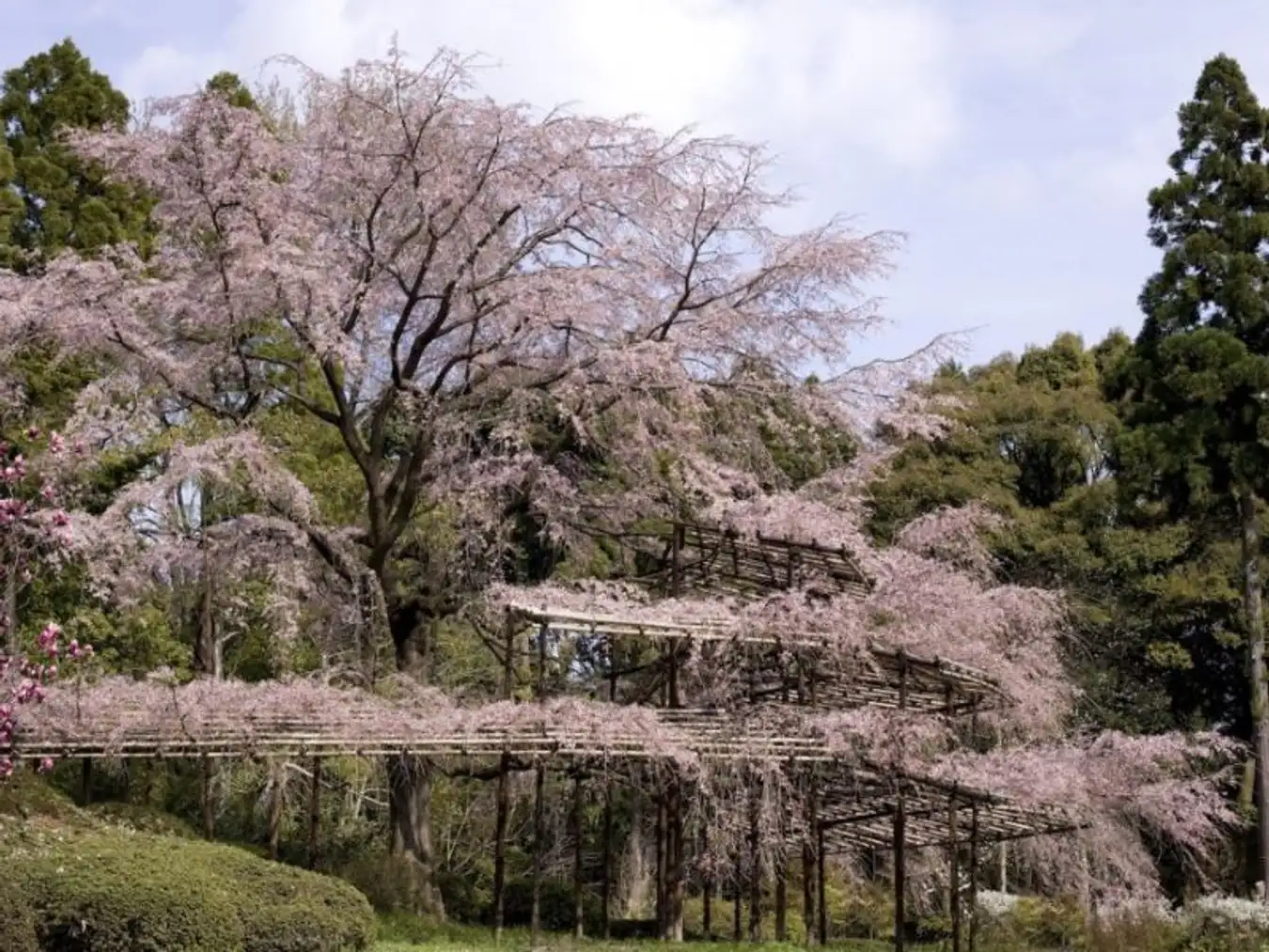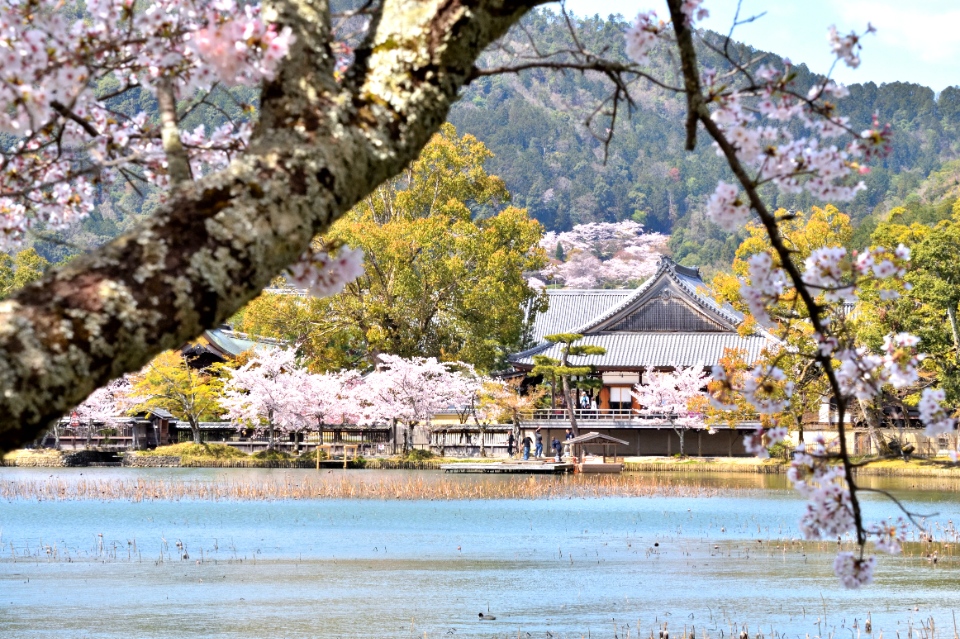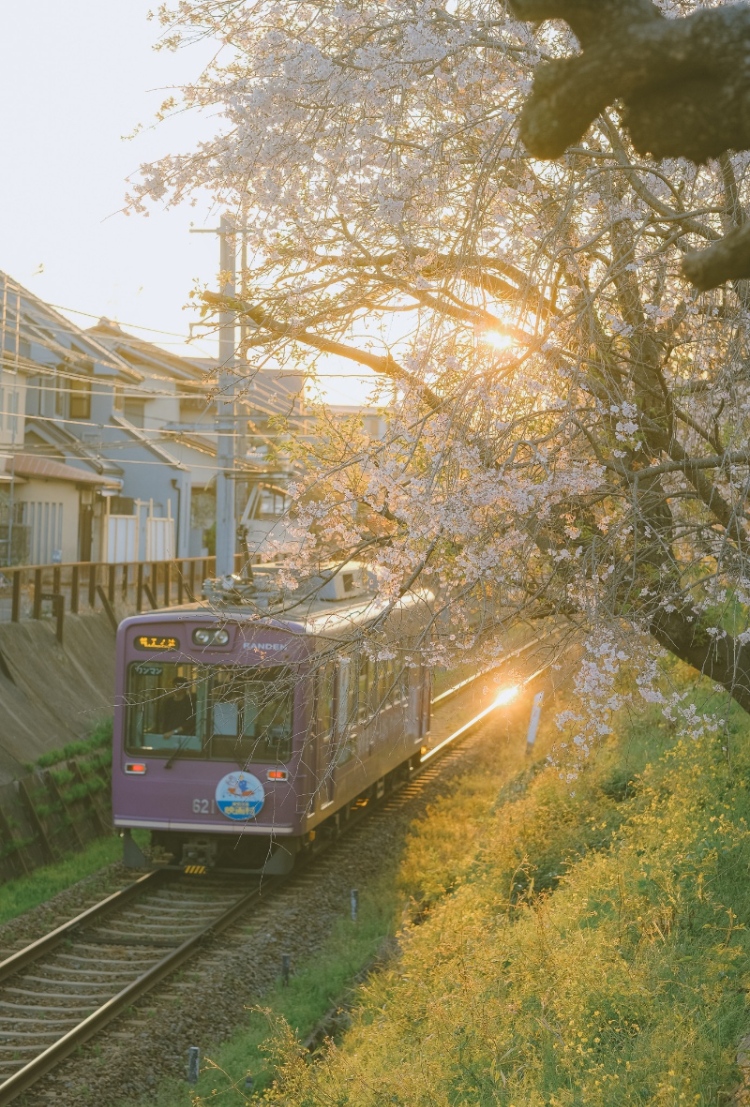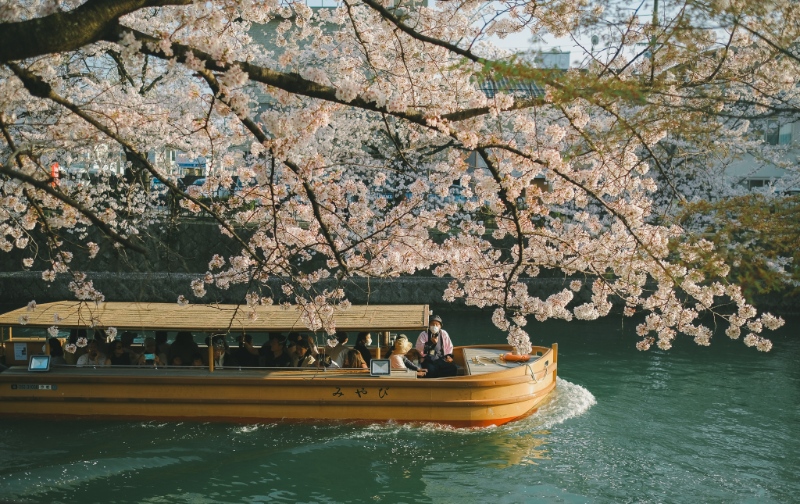Kyoto is a Japanese tourist city loved by tourists not only for its world-famous landmarks, heritage, historic shrines, temples, castles and delicate, delicious cuisine but also for being home to many of the most beautiful cherry blossom viewing spots in spring every year. So, are you planning a trip to Kyoto and finding best sakura spots in Kyoto for this cherry blossom season? Let’s check out Kyoto cherry blossom 2025 forecast with the first date of blooming, peak and full in bloom and 9+ best place to see cherry blossoms in Kyoto, best places to see sakura in Kyoto, best spot for cherry blossom in Kyoto as follows!
- Japan wisteria season 2025. Where to see wisteria in Japan & famous wisteria garden in Japan
- Osaka cherry blossom 2025 forecast. The dates & 21+ best cherry blossom spots in Osaka
- Tokyo cherry blossom 2025 forecast. The dates & 9+ best spots to see cherry blossoms in Tokyo
- Fukuoka cherry blossom 2025 forecast. 6+ best spots & where to see cherry blossoms in Fukuoka
- What is Hanami in Japan? The meaning & 9+ best places for Hanami in Japan




Cherry blossom season (sakura season) is coming and if you can wear a kimono and walk through the picturesque places filled with cherry blossoms, it will be wonderful and memorial moments.



Did you know, every time March comes, Japan is covered with pink cherry blossoms on every corner. This is one of the occasions when you can immerse yourself in the festive and bustling atmosphere of tourists and people in the land of the rising sun. If you plan to visit Japan this season, besides Tokyo, let’s try going to see cherry blossoms in Kyoto with us!


Admiring cherry blossoms in the ancient capital of Kyoto is an experience not to be missed if you have the opportunity to visit Japan in the spring. The image of cherry blossoms shining on beautiful traditional streets like Gion Street or Togetsukyo Bridge in Arashiyama, or the sight of cherry blossoms blooming in the beautiful Japanese-style grounds of Kodaiji Temple, you will feel like the scene is a miniature magical world. In the article below, we will share with you the 17+ most beautiful cherry blossom viewing spots in the ancient capital of Kyoto, Japan.
The best time to see cherry blossoms in Kyoto (# kyoto cherry blossom 2025 forecast)

Mentioning Japan means mentioning the land of cherry blossoms. Every year when spring comes, cherry blossoms bloom for about a few weeks, adding color to every road, parks, shrines, temples, countryside and along river banks. Cherry blossoms in Japan usually bloom from late March to early April and in each city they bloom on different days.
For Kyoto cherry blossom 2025 forecast, the best time to see cherry blossoms in Kyoto is between March 27 (first bloom) and April 4 (full bloom).


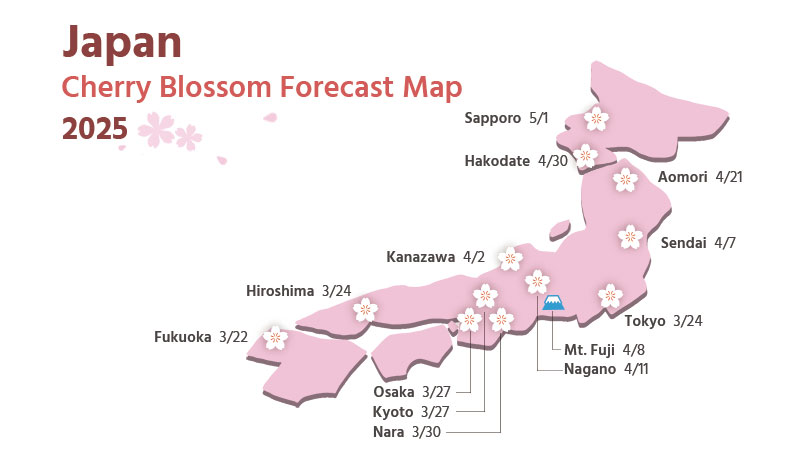
The time when cherry blossoms bloom is only 1 or 2 weeks, then the flowers will gradually fade, and especially if there is a passing rain and the rain is quite strong, the cloud of flowers will become a carpet of flowers or a river of flowers, but the scene is still so beautiful.


Best places and best place to see cherry blossoms in Kyoto (# best sakura spots in kyoto)

When cherry blossom season comes in Japan, people will organize the Hanami festival (also known as the cherry blossom viewing festival). At this time, people will spend time with their loved ones and organize outdoor picnics and spring trips to see flowers. Here is a list of beautiful places you must visit when viewing cherry blossoms in Kyoto.
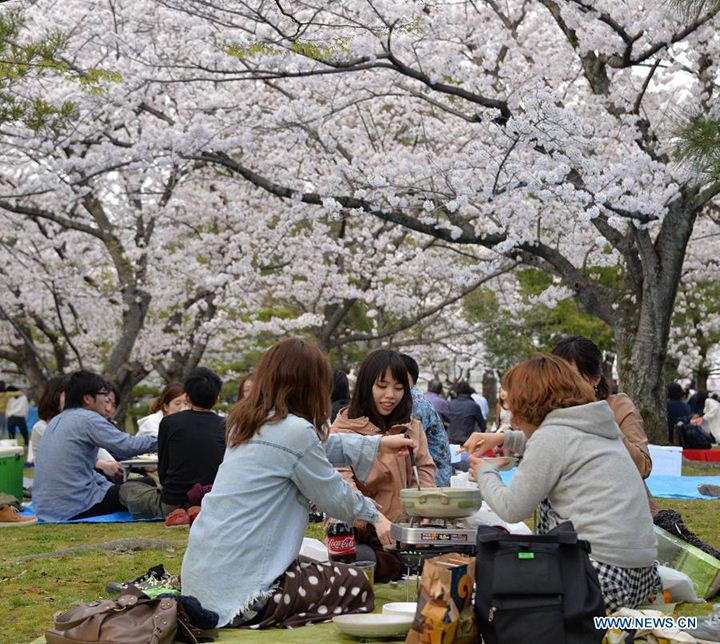

Philosopher’s Path (Tetsugaku-o-Michi) (# best place to see cherry blossoms in kyoto)
Location: Shishigatani Honenin Nishimachi, Sakyo Ward, Kyoto City, Kyoto Prefecture, Japan

The Philosopher’s Path (Tetsugaku no michi) is a beautiful paved road throughout the northern part of Kyoto’s Higashiyama district. About two kilometers long, the path begins at Ginkakuji (Silver Temple) and ends near the neighborhood of Nanzenji. The path is named after Nishida Kitaro, one of Japan’s most famous philosophers, who is said to have walked the path while practicing meditation on his way to Kyoto University every day.

Located between Ginkaku-Ji Temple on one side and Nanzenji Temple on the other, Philosopher’s Walk is a pedestrian path that follows a cherry tree-lined canal in Kyoto, was first inaugurated in 1890. With a length of 2km, this road is covered in white and pink colors with more than 500 cherry blossom trees with wide branches and green bushes creating a beautiful landscape. The scenery is peaceful, gentle and very beautiful. Philosopher’s Path is ranked first in the list of the most beautiful places to see cherry blossoms in Kyoto that tourists cannot miss when traveling to this ancient capital city.

This beautiful cherry blossom viewing spot is often considered one of the best places to take a stroll in spring. And it looks absolutely amazing in early April when all the cherry trees are in full bloom, making the road look like a fairyland and also the most visited place in the city.
Philosopher’s Path is a 2 km trail running along the canal lined with rows of brilliant cherry trees. The beautiful scenes and restaurants along the way promise to be interesting discoveries with many attractions that will definitely surprise you.
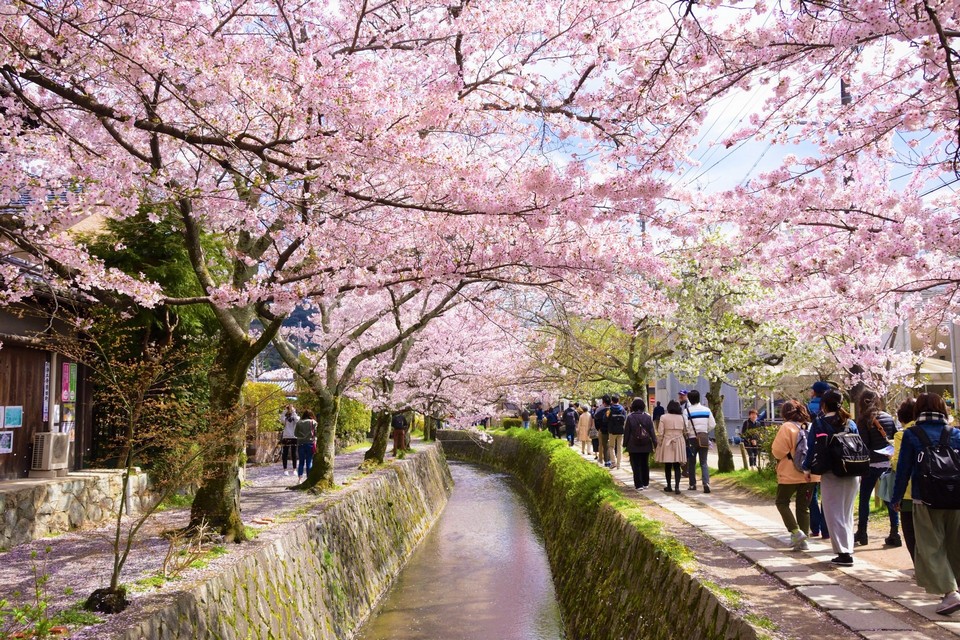
Nijo Castle (# best places to see sakura in kyoto)
- Address: 541 Nijojocho, Nakagyo Ward, Kyoto (a few steps from Nijojo-mae station, on the Tozai Subway line)
- Visiting hours: 8:45 – 17:00
- Dntrance fee: 600 JPY
- Lighting Festival: March 24 – April 16, from 6:00 p.m. to 9:30 p.m. (21:00 is the last time to enter), entrance fee is 400 JPY
Another sightseeing spot located on the Tozai Subway line that we would like to recommend is the Nijōjō castle. In Nijo castle, there are many different types of cherry blossoms, which means that the cherry blossom season here is quite long, almost throughout March and April, but it also means that the cherry blossoms here will be sporadic because the some bloom first, some bloom later, not all at once like other places. There are also lights here in the evening.
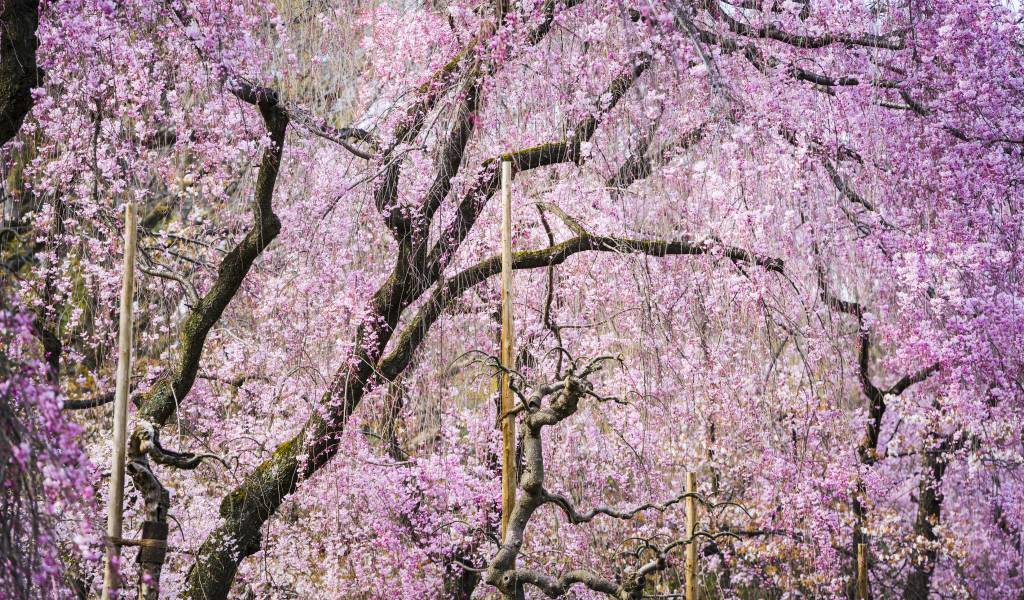
Coming to Nijo Castle, there is a special spot that we will reveal to you: This is a very special place to see cherry blossoms in Kyoto because the cherry blossoms here not only bloom earlier than other places but bloom longer; roughly from the end of March to mid-April. With more than 500 cherry trees grown from more than 50 different varieties, you can admire flowers of all colors, sizes and shapes. The most popular among them is the Shidarezuka tree with long branches drooping to the ground. Not only is the scenery of peach blossoms beautiful and graceful, the architecture of the old Nijo castle standing extremely majestic and majestic will bring a scene that is both ancient and poetic.

Another world cultural heritage of the land of the rising sun. Coming to Nijo Castle, Japanese tourists will have a journey to experience and learn interesting things about the history and unique traditions of this country from ancient times.
Inside Nijo Castle is a wonderful cherry garden with more than 50 rich and diverse peach varieties such as Yamazakura, Yaebenishidarezakura or Ooshimazakura… The best time to see cherry blossoms is from mid-March to the end of April and you will Must pay a ticket fee of about 600 Yen.
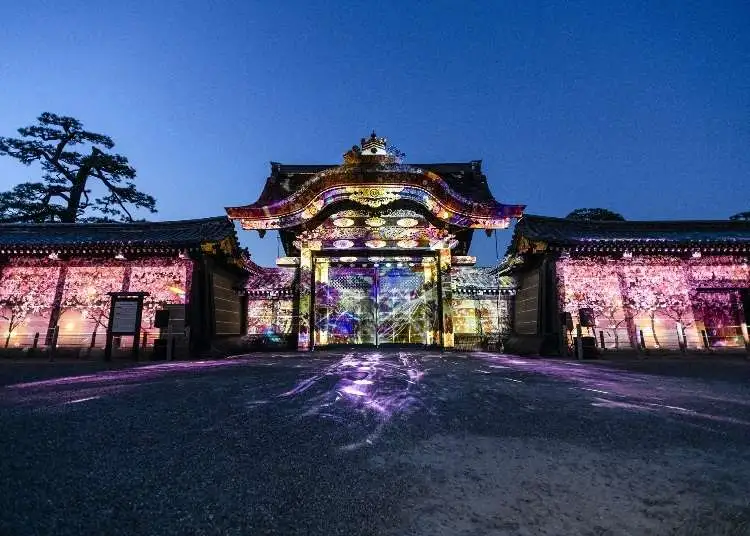
It is known that this ancient castle was recognized as a UNESCO world heritage site in 1997. Not only is it open during the day, but it also has a flower lighting program at night, creating an extremely sparkling and magical scene that attracts a large number of people to watch. This is definitely a place worth visiting to see cherry blossoms in Kyoto.
Kiyomizu-dera Temple (# best spot for cherry blossom in kyoto)
A beautiful cherry blossom viewing spot in Kyoto that should not be missed is Kiyomizu-dera Temple known as the “Pure Water Temple”. The temple was founded by the priest Enchin and the layman Gyoei. The name Kiyomizu-dera comes from the resounding sound of water flowing into the Otowa waterfall in Otowayama mountain.

Kiyomizu-dera is one of Japan’s most famous temples. It was founded in 780 on the site of Otowa Falls in the forested hills east of Kyoto and takes its name from the pure waters of autumn. The temple was originally affiliated with the Hosso sect, one of the oldest schools in Japanese Buddhism, but established its own Kita Hosso sect in 1965. In 1994, the temple was added to the list. UNESCO’s list of world heritage sites.

Kiyomizu-dera’s most famous feature is the wooden courtyard right in front of the main building, 13 meters above the hill below, where visitors can gaze across a sea of color, with the pink of cherries in spring (actually, very little if seen from the main hall, because the largest cluster of cherry trees here is around the pond near the exit), and the yellow mixed with red mixed with a little green of the maple leaf forest in autumn. Actually, we feel that Kiyomizu-dera is more beautiful in the fall, because the delicate color of the cherry blossoms is not enough to highlight the grandeur of the temple, but instead gives the temple an old, quiet look, in general, it’s beautiful but it’s a nostalgic beauty.

Behind Kiyomizu-dera’s main hall is Jishu Shrine, a shrine dedicated to the god of love and matchmaking. In front of the shrine are two rocks, placed 18 meters apart. Otowa Falls is located at the end of Kiyomizu-dera’s main hall. Its flow direction is divided into three separate streams and visitors use cups attached to long columns to drink from them. Each stream of water is said to have a different benefit, it will bless you with longevity, success in study, work and a lucky love life.
On the other hand, the scenery seen from here is beautiful beyond words. From here you can look towards the ancient capital of Kyoto and enjoy the changing scenery with the seasons. In addition, the night view here is very wonderful, so it is recommended that people visit during the lighting time. Special worshiping times at night will also change from year to year, so please research carefully before visiting.


Especially in the spring and fall, the temple lights up (illumination) as we described in Maruyama park, from 6:00 pm to 9:00 pm around mid-March (Hanatoro), late March to mid-April, and mid-November to early December, entrance fee is 400 JPY.
- Address: 294 Kiyomizu 1-chome, Higashiyama Ward, Kyoto (15 minutes walk from Kiyomizu-michi bus stop)
- Visiting hours (for reference): 6:00 – 18:00 (from mid-April to the end of July, the temple will be open until 18:30 on weekends and holidays, and throughout August and Open every day in September until 18:30)
- Entrance fee is 400 JPY
Shinbashi Dori (# best sakura spots in kyoto)
For those of you who focus on places to see cherry blossoms in Kyoto with beautiful views, and from any angle you can take a beautiful photo, you must definitely visit Shinbashi Dori. This place is known as one of the most picturesque streets located near Gion – Kyoto’s most famous geisha district.

Because it is a small, bustling street, the street beauty of Shinbashi Dori is clearly depicted in the late afternoon when the street lights are on and the shops are bustling with people. Suitable for those who like to walk around and understand more about the local culture here. Secret tip: you can rent kimonos to walk around and take pictures!
Hirano Shrine
For many years, Hirano Shrine has long been a favorite spot to enjoy cherry blossoms. The shrine was founded in 794, the same year that the Japanese capital moved to Kyoto, then called Heian-kyo. Pass under the bright torii gate of Hirano Shrine, and you’ll encounter more than fifty different species of cherry blossoms even before you reach the main hall. Flowers include Sakigake sakura, a variety that blooms in mid-March and is considered a harbinger of spring, as well as species that bloom in late April, making Hirano Shrine one of the places with the longest blooming period in Kyoto.

Located in the north of the ancient capital of Kyoto, the sakura (cherry blossoms) here are a symbol of enhancing the power of life. Therefore, in Hirano Shrine, more than 400 sakura trees with 60 different types of cherry are planted.
Japan is very famous for its temples with ancient architecture, preserved and preserved very well throughout the centuries. Hirano Shrine is one of the cherry blossom viewing spots in Kyoto that many people often visit.
On April 10, Hirano Shrine holds an annual traditional festival called Okashi. There are decorated with red umbrellas, yellow lanterns and seating, suitable for people to chat together, enjoy flowers, eat cakes made from sakura and drink tea. In the evening, there will be a flower lighting event for visitors to admire.

The Hirano Cherry Blossom Festival (Okasai) was revived in 1921, and since then has been held on the second Sunday of April every year. The cherry blossom festival begins in the morning and includes a ceremony at the Kazan Emperor’s mausoleum and a procession through the local neighborhood. At night, the sakura trees are illuminated with lights and the shrine is enlivened with yatai food stalls, live music performances and crowds gathering to eat, drink and be merry beneath the cherry blossoms.

Hirano Shrine is also a popular cherry blossom viewing spot for university students because it is close to Ritsumeikan University, so in spring many young people gather here. However, the temple is less famous than some of Kyoto’s famous spots, so it’s the perfect choice so you can enjoy the beautiful cherry blossoms without fighting the crowds.

How to get there: Hirano Shrine (Hirano-jinja), located in the area between Kinkakuji and Kitano Hakubaicho, is an easy walk from Kitano Tenmangu Shrine, Waratenjin and Kinkakuji. Alternatively, you can take a bus from Kyoto Station, with line 205 or 50 to Kinusaga Komae, or take a bus from Sanjo Keihan line 15 to the same station, or take Hankyu Railway from Shijo Omiya to the same station, or take bus line 204 from Kitaoji bus station. Free admission to the shrine. And if you are the type of person who gets lost very easily like me, I advise you to “let Klook take care of it”, taking the combined bus route from Osaka castle to Arashiyama and then get off here to visit the last stop is the best.
- Address: Okazaki Nishitennocho, Sakyo, Kyoto 606-8341, Japan
- Hours: 6 AM–5 PM
Daigoji Temple

Daigoji is one of the most famous temples in Japan, located in a rugged location but with extremely charming scenery, recognized as a world cultural heritage with the name “Historic Monuments of Ancient Kyoto”, with many national treasures and important cultural assets of the Japan being preserved. The temple’s most impressive cherry trees can be found in the garden of the Reihokan museum, located in the main courtyard of the temple (the temple has a precinct of over 2 million square meters, it’s so large that you can’t walk around). The Sanpo-in-teien Garden with a waterfall and a small island was designed to enhance the beauty of those weeping cherry trees (shidare-zakura). Because this place is so beautiful, I want to introduce to you, but getting to this place is also very hard. The time to see beautiful flowers is from late March to late April.

In spring, it is also the time when people and tourists take turns visiting the temple to pray, and more especially to admire the cherry blossom garden in full bloom throughout the pagoda’s grounds.
Daigoji Temple is one of the world’s cultural heritages and is also the pride of the people of Japan. This place possesses many cultural heritages, national treasures, pictures, precious Buddha statues… It can be said that Daigoji Temple plays a very important role in preserving and inheriting Japanese culture.

The Daigoji complex is a series of beautiful temples that cover an entire mountainside in Kyoto. Considered part of the historical monuments of ancient Kyoto, Daigoji includes a number of temples and historical buildings of great cultural value. Founded in the early Heian period (794-1185), Daigoji is an important site for Shingon Buddhism. However, during the Warring States period, which lasted nearly a century, Daigoji fell into disrepair and was almost forgotten.

It wasn’t until 1598, when Toyotomi Hideyoshi – considered one of Japan’s ‘great unifiers’ – held a grand cherry blossom viewing party in Kyoto, that Daigoji was revived. Hideyoshi planted over 700 cherry blossom trees and Sanboin with elegant renovations and a beautiful pond garden. The temple area is divided into 3 areas, Kami Daigo (upper temple), Shimo Daigo (lower temple) and Sanboin (literally “House of Three Treasures).
There are about 1,000 cherry trees in total and different types of cherry blossoms are planted around the complex grounds. There is a cherry blossom tunnel near the temple, Sakigake sakura in front of the temple and at Sanboin gadren. But the most prominent cherry tree in the temple will be the Sakigake sakura cherry tree located on the grounds of the Reihokan Museum.

How to get: If you go from Kyoto station, you can take the JR train to Yamashina (5 minutes by train, 190 JPY), then change trains to the Tozai Subway Line (8 minutes, 260 JPY). Alternatively, you can take the bus from Yamashina Station to Daigoji (Keihan Bus No. 22 or 22A), takes 20 minutes, costs 220 JPY, there is 1 trip every 20 minutes. In addition, Keihan Bus also has a direct trip from Kyoto station (in front of Keihan hotel), called “Yamashina Express”, this trip will take 30 minutes one way, the fee is 300 JPY, there will be 1 trip from every 30-50 minutes (you should ask the front desk to know the bus schedule from the day before, to get seats and tickets at the time you like).
- Address: 22 Daigo-higashi-oji-cho, Fushimi-ku, Kyoto Daigoji.
- Visiting hours: 9:00 – 17:00
- Entrance fee: 600 JPY to enter the Temple and enter Sanpo-in-teien garden
Kamogawa River

This is a tourist destination to see beautiful cherry blossoms in Kyoto that is popular with many international visitors. Kamogawa is a river that runs along Kyoto city. To see cherry blossoms here, visitors can walk, ride a bike or take a boat down the river to see the beautiful view of the Japanese cherry blossoms on both sides of the river, which will be a great idea for you.

The two rows of cherry trees along the Kamogawa River banks usually bloom between March 26 and April 10 every year and the ticket price for a scenic boat trip is 1,200 Yen.
Fushimi-Inari-taisha
Fushimi-Inari-taisha is the top shrine among 30,000 Inari-jinja shrines nationwide, it is also commonly known by the familiar name Oinari-san. Legend has it that this temple was built in the year 711. The sanctuary is about 870,000 square meters, centered on Inari-yama mountain. Fushimi-Inari-taisha Shrine is famous for its “Zenbon Torii” tunnel with many vermilion Torii gates located within the temple grounds.

Here there are more than 1000 red torii gates standing along the cherry trees and creating a majestic scene. Every year, many people come here to pray for prosperity and good business. To make their wishes come true or to thank them for their wishes being fulfilled, they donate many Torii gates to place at the temple. Currently, the number of Torii gates has reached about 10,000. The god worshiped at Fushimi-Inari-taisha Shrine is Inari-Daimyojin, famous for responding to prayers for prosperous business and good harvests.

The main hall was rebuilt in 1499 and is now recognized as an important cultural heritage. As soon as you pass through the Torii gate, you will see the place of worship at Okusha, (deep inside shrine), commonly called Oku-no-in. Nearby is the Omokaru-ishi stone. Legend has it that if you lift the stone and feel light, your wish will come true. In addition, at Inari-yama mountain there are many other small sub-shrines, the most notable of which is Ichinomine (Kamisha Shinseki) located at an altitude of 233m. The tour around the shrines on Inari-yama mountain is called “Oyama-meguri” and has a total length of up to 4km.
- Address: 68 Yabunouchi, Fukakusa, Fushimi District, Kyoto City
- Hours: Open 24 hours
Keage Incline
Previously, Keage was a 582m long railway that was later converted into a walking path so visitors can walk with rows of cherry trees stretching along the entire way. The cherry blossom here are mainly white or pink, creating a lovely, clear pastel color effect filled with spring colors.

Once an important traffic landmark during the Meiji period, the abandoned train tracks unintentionally made this place even more special. The canopy of cherry trees spreads along both sides of the train tracks with a peaceful scene, very suitable for tourists who love quietness and relaxation while admiring the scenery.
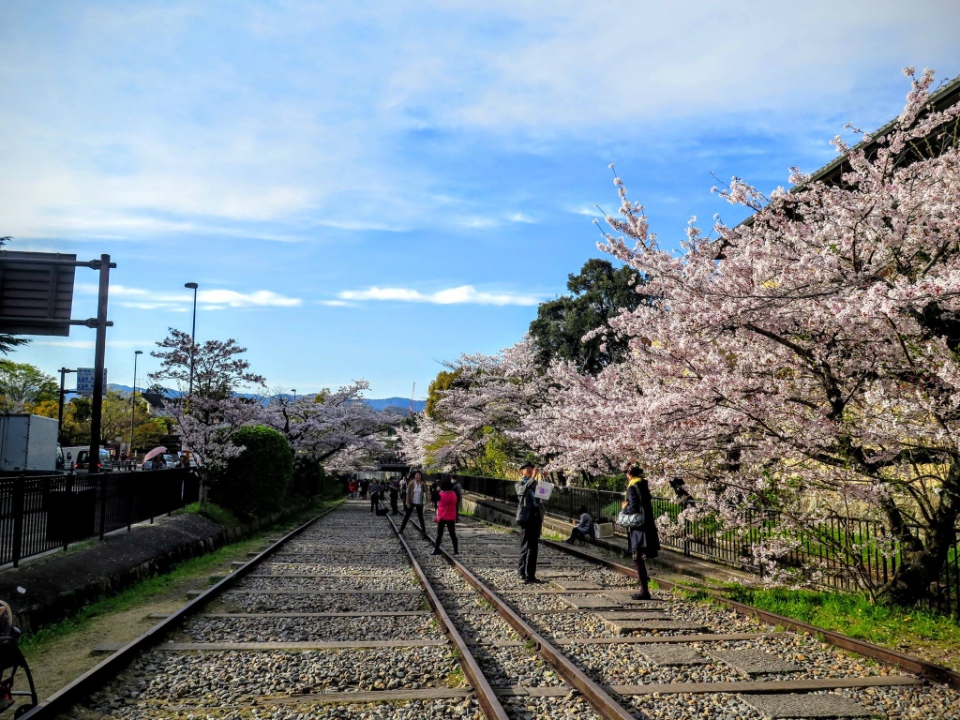
The most popular flower in this place is the Somei yoshino sakura (Yoshino cherry blossoms in full bloom) with beautiful, wide branches and leaves. Besides, this place is also suitable for couples to take photos when going to see cherry blossoms in Kyoto because this road includes two double tracks next to each other, you can walk hand in hand. like movies.
- Address: 339 Higashikomonozacho, Kyoto, 606-8435, Japan
- Hours: Open 24 hours
Ninnaji temple
Founded in 888, Ninnaji Temple is one of the greatest temples in Kyoto listed as a World Heritage Site. It is the head temple of the Omuro School of the Shingon sect of Buddhism and was founded in 888 by the reigning emperor. For centuries, a member of the Imperial Family served as chief priest of Ninnaji, and the temple was also known as the Omuro Imperial Palace. Due to the many wars and fires that ravaged Kyoto throughout its history, no buildings from the temple’s foundation in the 9th century still exist.

Ninaji is a Buddhist temple that plays an important role in Japan. Ninaji Temple stands out with its unique five-story temple architecture, gilded main hall and beautiful ornamental cherry blossom garden.
This is one of the most popular cherry blossom viewing spots in Kyoto city, attracting more than 10,000 tourists each year. At Ninnaji Temple, low cherry trees called Omuro Cherry can be seen. Omuro cherry trees start blooming 7 to 10 days later than other types of cherry blossoms such as Somei Yoshino. The best time to see the flowers at Ninnaji Temple is from early to mid-April, and is known to have the best cherry blossoms in Kyoto. In addition, Omuro cherry trees are shorter than other common cherry trees, with an average height of 2 m. Cherry blossom petals are larger and have a more vivid pink color.
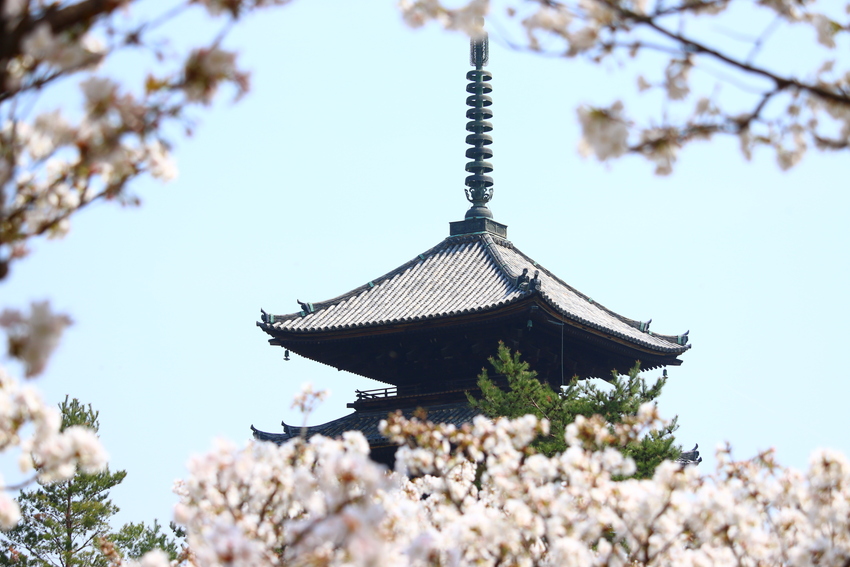

Ninna Temple (Ninna-ji), home to the Omura-zakura cherry blossoms, was originally a flower only for people of noble status, but by the Edo period (1603-1868), commoners could also enjoy it. permission to enjoy this flower. You can walk to the temple (about 10 minutes) from Omuro Ninnaji station (Keifuku Kitano line), ticket price 500 JPY, visiting time 9:00-17:00, the best time to see the flowers is from the beginning until until mid-April.
In particular, Ninaji Temple is also famous for Omuro Zakura flowers. A type of cherry blossom that often appears in Japanese poetry. And this is also the reason why many Japanese tourists come here to visit and enjoy the stunning beauty of this flower.

There are about 500 cherry trees in the temple complex and the best view is the cherry blossom area next to the large five-story temple. Ninnaji is a ten-minute walk west of Ryoanji Temple and just steps from Omuro Ninnaji Station on the Keifuku Kitano Line, a small train line, connecting Arashiyama with the Kitano district. From Kyoto Station, Ninnaji Temple can be reached by JR direct bus.
- Address: 33 Omurouchi, Ukyo Ward, Kyoto, 616-8092, Japan
- Hours: 9 AM–4:30 PM
Maruyama Park
For the people of the land of the rising sun, Maruyama Park has long been the most beautiful cherry blossom viewing spot in Kyoto. Every spring, more than 800 cherry trees compete with each other to bloom brilliantly, looking like a beautiful spring landscape painting, making visitors forever captivated and unable to leave.

Maruyama Park is the most famous park in Kyoto for cherry blossom viewing. In a large space of more than 86,000 square meters, there are more than 680 different cherry trees including rare cherry blossoms such as Yoshi and Yamazakura grown in the park.
The famous cherry tree that is considered the symbol of Maruyama Park is the Shidarezakura that is over 80 years old, always colorful, with flower branches drooping like a stream of water carrying delicate petals falling from the branches to the ground. In particular, when night falls, the park becomes the busiest, glowing with magical light reflecting from cherry blossom petals gently falling in the wind.
Also famous here is the giant Shidare cherry tree, which is the spring symbol of Maruyama Park. This giant cherry blossom tree attracts millions of tourists every year during its flower viewing period. At night, it looks amazing, especially when it is lit up by lights. Maruyama Park is the oldest park in Kyoto and is like a kaiyushiki-style garden with different sections of the park blooming in different seasons.

During cherry blossom viewing season, there are lights in the park that illuminate the cherry trees, giving the park a magical atmosphere similar to old Kyoto. During cherry blossom viewing there are many food stalls at the park.
In addition, you can sit and relax while watching cherry blossoms at the teahouses in the park, or enjoy the famous BBQ beef here. To get to Maruyama park, visitors take the Kyoto Shiei bus and get off at Gion station and walk about 5 minutes to get there.

Normally, Japanese people and tourists from all over the world will flock to central parks to celebrate the Ohanami festival. If you are passionate and want to learn about Japanese culture, you should visit Maruyama park in Kyoto, choose an empty tree, spread out a tarpaulin (buy it at the 100 Yen store, including tax), drink sake (I’m a fan of ume-shu wine, it’s delicious and fragrant), eat sakura cake, sing, socialize, and chat all day long (yozakura (yes, it’s yozakura, it’s Yozakura Quartet, manga and anime fans), meaning cherry blossoms at night, it’s also very beautiful).
- Address: 473 Maruyama-cho, Higashiyama-ku, Kyoto (5 minutes walk from City Bus Stop “Gion”)
- Free admission
Heian Shrine

When talking about Kyoto’s famous temples, it is impossible not to mention the temple, which is Heian Jingu Shrine, this shrine is just over 100 years old (in 1895, the 1100th anniversary of the Emperor Kammu moved the capital to Heian, which is present-day Kyoto). The highlight of this temple is the large garden of up to 30,000 square meters designed in a modern style, with rows of cherry trees reflecting on the lake. The cherries at Heian Jingu bloom quite later than other cherry trees, making this a popular cherry blossom viewing spot at the end of the flowering season, usually around mid-April.

Each cherry blossom viewing spot in Kyoto leaves visitors with unforgettable memories. But perhaps no place brings as many sublime emotions as Heian Shrine. The ancient temple is more than 1,000 years old with unique, simple traditional architecture in harmony with the white and pink color of the cherry trees, creating a rare, magical and ancient beauty.
Heian Shrine is a Shinto shrine located in Sakyo-ku, Kyoto. It is considered an important cultural heritage of Japan. The shrine has one of the largest torii gates in Japan and the site includes a bright red main hall, pond and Japanese garden. Heian-jingu was built in 1895, on the occasion of the 1100th anniversary of the move to the capital Heian, and is very impressive with the temple gate and main hall painted bright red.
At night, tourists can admire beautiful Geishas or Maikos dressed in kimonos walking slowly and gently through the alleys in the old town of Gion.

Here, you will see about 300 Sakura trees with about 20 varieties, including mainly Yaebeni-shidare, Yomei-yoshino, Higan-zakura, Yama-zakura… Especially, in the evening, the pink Sakura flowers appear. down to the lake creates an unbelievably wonderful space. Visitors are encouraged to visit the temple on days when there are special events in the evening such as music performances… The entrance fee is 600 yen, but during Sakura blooming time (from March to April) admission is free.
- Address: Okazaki Nishitennocho, Sakyo Ward, Kyoto (can take Kyoto City bus number 5 or number 100, about 30 minutes from Kyoto station)
- Visiting hours: 6:00 – 17:30 (for Heian Jingu) and 8:30 – 17:00 (for Heian Jingu inner garden)
- Entrance fee: Free for Heian Jingu and 600 JPY if you want to visit the garden
Haradani-en Garden

In Kyoto, when sakura flowers bloom, everywhere is bright pink. But this place is often considered the best place to see cherry blossoms. Haradani-en Garden is located on a hill above Kinkakuji temple in the northern area of Kyoto city. Few tourists know about Haradani-en garden – this is a private cherry blossom site known only to locals. Although this is a lovely and pleasant garden to visit any time of year, it is truly wonderful during cherry blossom season.

The garden is privately owned and only open during limited times, usually for cherry blossom viewing in the spring and for viewing in the fall. There are more than 400 and 20 different types of cherry trees in the 13,000 square meter garden. The garden is famous for its beautiful weeping cherry trees. Weeping cherry trees are late bloomers compared to other trees so viewing is usually available until mid-April. The garden has other spring flowers such as azalea, apple and rhododendron which create a magnificent scene with cherry blossoms.
The best time to visit is from late March to mid-April. It’s off the tourist trail and a bit difficult to reach but absolutely worth a visit.
- Address: 36 Okitayamaharadaniinuicho, Kita Ward, Kyoto, 603-8487, Japan
- Admission: Haradani Garden, northwest of central Kyoto, ticket price 1200 JPY for weekdays and 1500 JPY for weekends and holidays
- Visiting time is 9:00 – 17:00, the best time to see the flowers is mid April.
Okazaki Park

This park will give visitors an immersive experience with the unique scenery of cherry blossoms blooming in the riverbed. Did you know, Okazaki was once voted as a beautiful cherry blossom viewing spot in Kyoto. The highlight here is that visitors will be able to walk around and enjoy cherry blossoms on small boats for about 30 minutes at a time.
Togetsukyo Bridge
Togetsu-kyo Bridge was built more than 1000 years ago during the Heian period (794 – 1185), spanning the Katsuragawa River (Oi-gawa River) in front of Mount Arashiyama. This bridge is 155 meters long, with columns and beams made of reinforced concrete, only the parapets are made of wood. The original location of the bridge is about 200 meters upstream. However, after experiencing many floods and being burned down, the bridge moved several times to its current location in 1606.

At times of the year, when the surrounding scenery changes, Togetsu-kyo Bridge always maintains its ancient and fresh beauty, never becoming “out of place”, but blending in perfectly with beautiful natural scenery on both banks. Therefore, whether it is the red and yellow foliage in autumn, or the brilliant cherry blossoms in spring, or the young blue buds in summer, or the white snow of winter, they are just the backdrop that helps Togetsu-kyo Bridge stand out. brighter and more radiantly beautiful.
Tourists visiting the bridge can also cruise on the river by covered boats, to experience the feeling of gently gliding on the water, and admire the beautiful surrounding scenery. Besides, at the end of summer, visitors also have the opportunity to observe the extremely interesting traditional Ukai cormorant fishing activities of local people here. In particular, every December, the Arashiyama Hanatora festival takes place, brightly lighting up Togetsu Bridge with traditional Japanese Andon lanterns, creating a sparkling, magical space.
- Address: Tenryuji-susukinobaba-cho, Ukyo-ku, Kyoto
Kyoto Botanical Gardens
See cherry blossoms in Kyoto at a botanical garden, why not? Because it is a botanical garden, this place is always covered with green leaves and colorful flowers of all colors and sizes. Inside the Kyoto Botanical Gardens in spring there is also a beautiful small garden adorned with the white and pink parts of the weeping cherry trees (Shidare zakura) and five-petal cherry trees (Somei yoshino) that are very charming and gentle. In addition, this place also organizes a flower lighting program from March 25 to April 9 (until 9:00 p.m.) for tourists to visit and sightseeing.
- Address: Shimogamo Hangicho, Sakyo Ward, Kyoto, 606-0823, Japan
- Ticket price and opening hours: 9:00-17:00 (200 yen/ticket)
Arashiyama
And, the last place, is the famous mountain that you must visit in the fall and the same in the spring all year round, you should visit it because it has both a lake and a mountain and cherries in the spring with bright red leaves. corner of the sky in autumn, I’m talking about Arashi Yama / Togetsu-kyo Bridge is considered the most famous spot and the center of the Arashiyama area, where hundreds of shops sell souvenirs Famous concepts and restaurants (after coming to Kyoto to eat Matcha, you won’t want to eat at home anymore because eating it will make you crave more and want to go again, you should be careful, if you’re addicted).

I once got lost in a shopping area that left out all the sights (because I was on tour) and awkwardly carried all the little things to the car that were still as good as new after more than 5 years (that was the first time, next time, learn from the experience of staying longer to go sightseeing before going shopping again.) Famous attractions of this area include Tenryu-ji temple, the path through the green-leaf bamboo forest with soft sunlight filtering through the leaves, famous for Sagano (in December there is Arashiyama Hanatoro, the bamboo trees will be illuminated, shining from the lantern lights, extremely shimmering and magical). In addition, there are many more so I won’t mention them all here. I’ll post an article about Arashiyama later.
Arashiyama is one of the beautiful cherry blossom viewing spots in Kyoto that visitors should not miss. This tourist area is located on the outskirts, at the foot of Mount Arashimaya. So when you come here, you will not only be able to see the cherry blossoms blooming, but also enjoy the fresh air and peaceful, rustic natural scenery of the land of the rising sun.
Visitors come to Arashiyama at Hankyu Arashiyama station, Saga Arashimaya station or bus number 28 from JR Kyoto to Arashimaya-Tenryuji-mae station.
There are countless ways to go to Arashiyama
By JR: 1 direct trip from Kyoto station on the JR Sagano line (also known as JR Sanin Line) and get off at Saga-Arashiyama after 15 minutes on the train and pay 240 JPY, then walk about 5-10 minutes is to go to Arashiyama center.
Going to Keifuku Railway (Randen): Right in the center of Kyoto, at the intersection of Shijo Street and Omiya Street, you can take the Keifuku train from Omiya station and arrive at Keifuku Arashiyama station located right in the center of Arashiyama, for 210 JPY and Travel time is 20 minutes. Keifuku Railway also has trains to Kitanohakubaicho Station in Northern Kyoto, very close to scenic spots such as Kinkakuji, Ryoanji and Ninnaji for 210 JPY and 20-30 minutes by train. (Note that there are train changes so it’s a bit difficult to get there).
Take the Hankyu Railway (you also have to change trains): Also in central Kyoto, Shijo street, you take the train at Kawaramachi station or Karasuma station, take the Hankyu Main Line to Katsura station, then change to the Hankyu Arashiyama line to get Arashiyama. One-way trip takes about 20 minutes and the ticket price is 220 JPY. Note that Hankyu Arashiyama station will be on the other side of the river, walking to Arashiyama center takes about 5-10 minutes.
Take the bus: There are many bus routes to Arashiyama from central Kyoto, however I do not recommend it if you want to go straight to Arashiyama because it is easy to get stuck in traffic and the tourist bus route will pass through scattered scenic spots, so it will take a more time.
Take a boat trip while admiring flowers
We’ve walked, taken the train, now let’s take a boat on the river to see the peach blossoms for romance. To row a boat to see the flowers, you can rent a boat to row yourself (if you are confident in your ability to row) or take a large boat with a driver, you can just take pictures and admire the scenery in Arashiyama, or another famous spot along Okazaki Canal. Here you can choose between walking or cycling along the canal, or you can take a boat (boarding price is 1200 JPY) down the Okazaki River, and see famous tourist attractions on the banks that the you’ll likely pass by including Heian Jingu, Kyoto Museum of Art, Okazaki Park.
The cherry blossom season in Kyoto usually falls in the last week of March until mid-April every year. And this is also the ideal time to see cherry blossoms for you. The beautiful cherry blossom viewing locations in Kyoto that we has just introduced above promise to bring you many interesting discoveries during your travel journey to the ancient capital of Kyoto.
Some best day tours, trips, activities and transfer services, tickets in, to and from Kyoto you can refer to
- Private Kansai International Airport Transfers (KIX) for Kyoto
- Limousine Bus Transfers between Kansai International Airport (KIX) and Osaka or Kyoto
- Shared Night Bus Transfers from Kyoto to Tokyo
- Private Kansai Airport (KIX) Transfers to Osaka, Kyoto, Nara, Uji, Kobe, or Arima
- Kyoto-Osaka Sightseeing Pass (1 Day/2 Days, Kyoto Pick Up)
- Kyoto-Osaka Sightseeing Pass 1 Day/2 Days (Pick up at Osaka)
- Randen + Subway 1 Day Pass
- Kyoto Temples & Shrines Day Tour from Osaka: Fushimi Inari-taisha, Arashiyama, Kiyomizu-dera & More
- Kyoto Perfect Day Tour from Osaka or Kyoto: Kiyomizu-dera, Fushimi Inari-taisha, Arashiyama & More
- Kyoto and Nara Day Tour from Osaka/Kyoto
- Kyoto Afternoon Tour from Osaka
- Hankyu Tourist Pass
- Kyoto and Nara Day Tour from Osaka/Kyoto
- Sagano Romantic Train One-Way Ticket (Saga or Kameoka Departure)
- Kimono Rental and Photoshoot in Kyoto by Ouka Kimono
- Kyoto Sagano Romantic Train Day Tour
- Kyoto Temples & Shrines Day Tour from Kyoto: Fushimi Inari-taisha, Arashiyama, Kiyomizu-dera & More
- Amanohashidate & Miyama One Day Tour from Osaka/Kyoto
- JR Kansai-Hiroshima Area Pass
- Kimono Rental in Kyoto Kiyomizu Temple
- One Day Kimono Rental
- Kyoto Temples & Shrines Day Tour from Osaka
- Kimono and Yukata Rental at Kimono Miyabi Kyoto
- 4G Prepaid Sim Card (JP Airports Pick Up) for Japan
- 4G WiFi (Japan Pick Up) for Japan
- JR Pass for Whole Japan (7, 14, or 21 Days)

Are you finding more top things to do in Kyoto: Tours, activities, attractions and other things? Let’s check it out at here. And read more: Kyoto blog (Kyoto travel blog) — The fullest Kyoto travel guide blog for a budget trip to Kyoto, Japan for the first-timers. And Kyoto 3 day itinerary — How to visit Kyoto in 3 days & what to do in Kyoto in 3 days perfectly?































![10 best airports in Asia in 2016 [RANKED] kuala-lumpur-international-airport-best airports in asia in 2016 by skytrax ratings](https://livingnomads.com/wp-content/uploads/2016/08/29/kuala-lumpur-international-airport-best-airports-in-asia-in-2016-by-skytrax-ratings-218x150.jpg)










